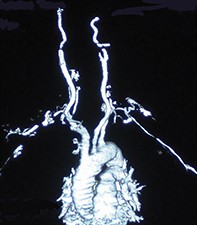Peer Reviewed
Feature Article Rheumatology
Polymyalgia rheumatica and giant cell arteritis
Abstract
Patients with a past history of the relatively benign condition polymyalgia rheumatica should be viewed as candidates for the development of giant cell arteritis, the major morbidity of which is visual loss that can become permanent if the condition is untreated.
Key Points
- Polymyalgia rheumatica and giant cell arteritis are relatively common related inflammatory conditions in people aged over 50 years. The aetiology is unknown.
- About 10% of patients with polymyalgia rheumatica develop giant cell arteritis, and about 30 to 40% of patients with giant cell arteritis have associated polymyalgia rheumatica.
- Neither condition should be diagnosed in patients under 50 years of age, and polymyalgia rheumatica should not be invoked as an explanation for unilateral symptoms.
- Patients with a past history of polymyalgia rheumatica should be viewed as candidates for the development of giant cell arteritis, the major morbidity of which is visual loss.
- Giant cell arteritis should be considered in an elderly patient with pyrexia of unknown origin.
Purchase the PDF version of this article
Already a subscriber? Login here.

